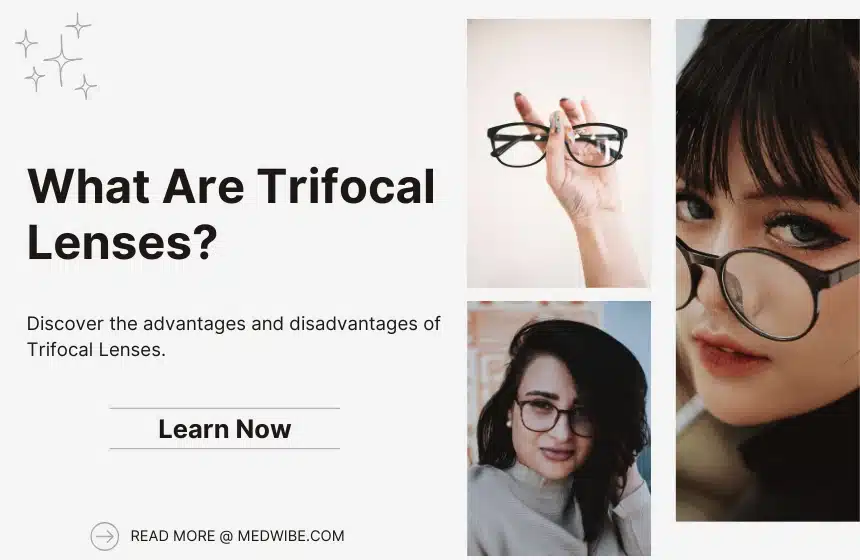Key Features
- Trifocal lenses are a type of eyeglass lens designed with three distinct sections to correct vision at near, intermediate, and far distances.
- They are typically used by people who need correction for near, intermediate, and distant vision, often due to aging.
- These lenses offer clear vision eliminating the need for multiple glasses.
- Such lenses are helpful for people who need assistance with activities like reading, computer work, and driving or recognizing distant objects.
- The average price for trifocal lenses can range from around $120 to over $400, not including the cost of the frames.
What Are Trifocal Lenses?
Trifocal lenses are an advanced type of eyeglasses designed to correct vision at three different distances: close, intermediate, and far. They are particularly beneficial for individuals experiencing presbyopia, a common condition that affects the eye’s ability to focus on close objects as we age.
Advantages of Trifocal Lenses

Trifocal lenses offer several advantages, making them a popular choice for people with specific vision needs, especially those requiring correction for multiple distances. Here are some of the key benefits:
Versatility in Vision Correction
Trifocals correct vision at three different distances – near, intermediate, and far – making them ideal for a wide range of activities. This eliminates the need for multiple pairs of glasses for different tasks.
Convenience and Ease of Use
With one pair of glasses, users can seamlessly transition between tasks like reading, using a computer, or driving.
Reduced Eye Strain
By providing clear vision at all necessary distances, trifocals can reduce eye strain associated with focusing on objects at different ranges. This is especially important for individuals who spend long hours in front of screens or engaged in detailed work.
Suitable for Progressive Presbyopia
As presbyopia progresses, the need for multifocal correction increases, making trifocals a suitable choice. They provide a comprehensive solution as one’s vision changes over time.
Disadvantages of Trifocal Lenses

While trifocal lenses offer numerous advantages, it’s important to consider their potential disadvantages to make a fully informed decision. Understanding these drawbacks can help in evaluating if trifocals are the right choice for your vision needs.
Adjustment Period
New wearers often experience a period of adjustment when learning to look through the correct part of the lens for different distances. This can lead to initial discomfort and a temporary disruption in daily activities.
Narrow Field of View
The intermediate and near vision sections of such lenses are smaller compared to single vision lenses, providing a narrower field of view. This can require more head movement to achieve the desired focus, which some find inconvenient.
Visual Distortion

The distinct separation between the different focal areas can cause a ‘jump’ in the image when moving your eyes from one section to another. This can be disorienting, particularly for activities that require rapid changes in focus, like descending stairs.
Cost
Trifocal lenses can be more expensive than single vision lenses, particularly when customized with additional features like anti-reflective coatings or high-index materials. The higher cost can be a significant consideration for some individuals.
Lens Size and Weight
To accommodate the three distinct sections, these lenses may need to be larger and can be heavier than single vision lenses. This can affect comfort, especially for those sensitive to the weight of glasses.
Explore the concept of 20/50 vision and its implications. Understand what 20/50 vision means for your eye health.
Types of Trifocal Lenses

Following are the some common types of Trifocal lenses:
Progressive Trifocal Lenses
Progressive trifocals offer a gradual transition between the three focal areas without visible lines. This design provides a more natural visual experience.
These lenses are suitable for those seeking a line-free, more aesthetically pleasing lens that mimics natural vision progression.
Anti-Reflective Coated Lenses
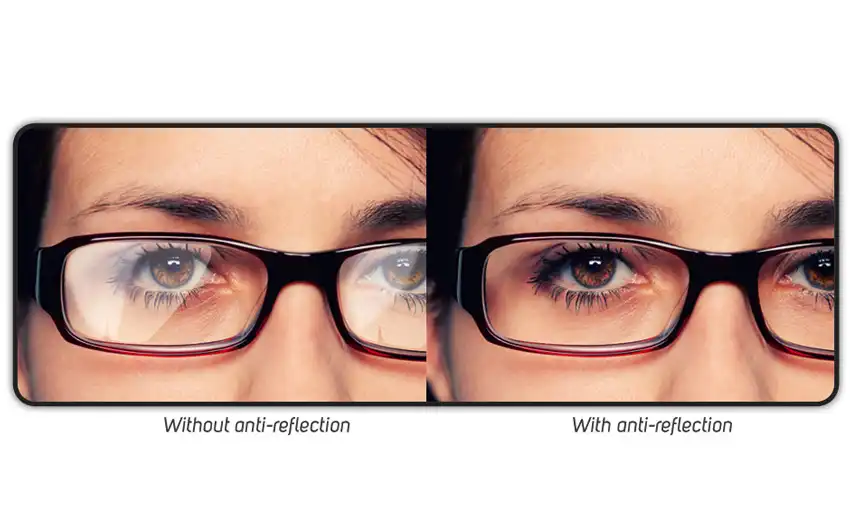
These lenses come with a special coating that reduces glare, reflections, and halos around lights, making them ideal for night driving and computer use. Individuals who spend a lot of time in front of screens or driving at night can use these lenses.
Polycarbonate Trifocal Lenses
Polycarbonate lenses are made from a durable, lightweight material, these lenses are impact-resistant, making them an excellent choice for sports or active lifestyles.
These lenses are best for active individuals or children who need sturdy, safe eyewear.
Photochromic Lenses
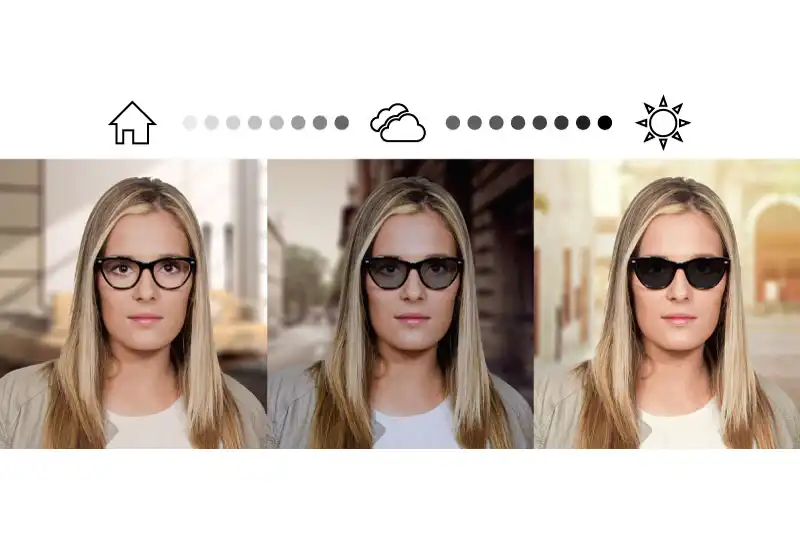
These lenses automatically adjust their tint based on light conditions, providing comfortable vision indoors and UV protection outdoors.
Such lenses are suitable for individuals who frequently move between indoor and outdoor environments and want the convenience of not switching glasses.
High-Index Trifocal Lenses
These lenses are made from a high-index material, these lenses are thinner and lighter than standard plastic lenses, ideal for higher prescriptions.
People with strong prescriptions who prefer lighter and more comfortable glasses can use these lenses.
Working of Trifocal Lenses

Trifocal lenses are designed to correct vision at three different distances: near, intermediate, and far. Such lenses are divided into three different sections. The working of each section is described below:
Top Section (Distance Vision)
The top section is designed for seeing distant objects clearly, like when driving or looking at a street sign. This part of the lens has the least amount of magnification, catering to far vision.
Middle Section (Intermediate Vision)
This part of lens is Ideal for computer use or viewing objects at an arm’s length, such as a dashboard in a car. This section has a slightly higher magnification than the top part, allowing for comfortable vision at intermediate distances.
Bottom Section (Near Vision)
Bottom section is used for reading or doing close-up tasks like sewing or crafting. This area has the highest magnification, facilitating clarity for near tasks.
Find out information regarding different types of visions on any of the healthcare blogs in USA.
Uses of Trifocal Lenses
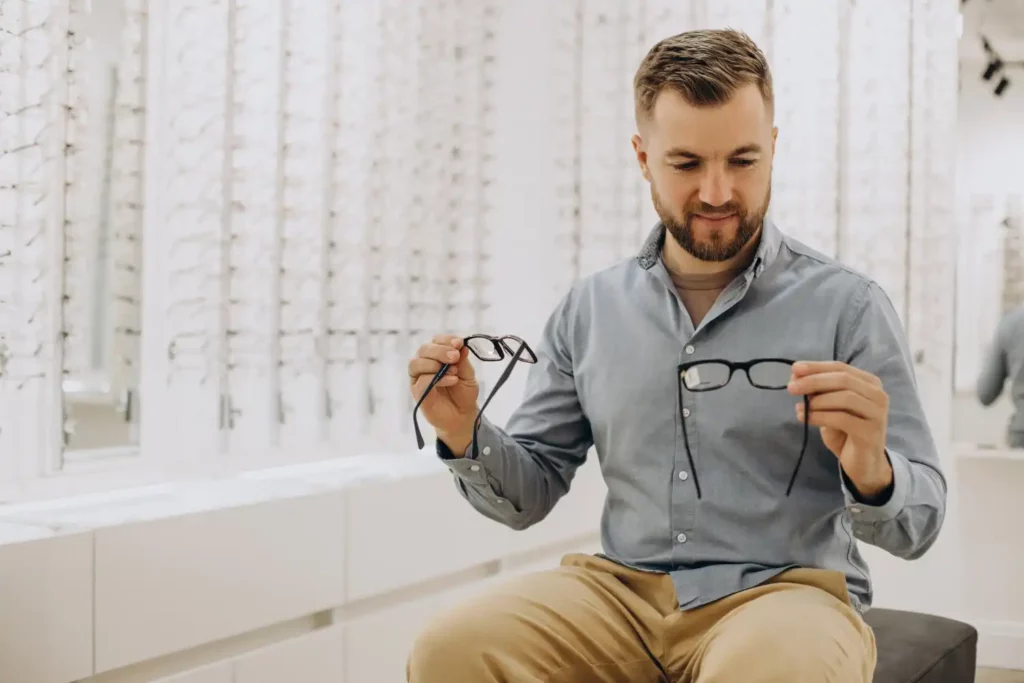
Trifocal lenses have a variety of uses, making them a versatile choice for many individuals, especially those who experience changes in their vision due to age or other factors. Let’s explore the common uses of these lenses:
Reading and Close-Up Work
Trifocal lenses are ideal for reading books, newspapers, or working on hobbies like sewing or model-building.
Computer and Intermediate Distance Work
These lenses are perfect for using computers, smartphones, or viewing any object at an arm’s length. They provide clear vision at intermediate distances, reducing eye strain during prolonged screen time.
Driving and Distance Viewing

These lenses are also very essential for driving, watching movies in a theater, or attending sports events.
Workplace Efficiency
These lenses are beneficial in professional settings where one might need to look at different distances frequently, such as in laboratories, offices, or manufacturing plants.
Cost of Trifocal Lenses
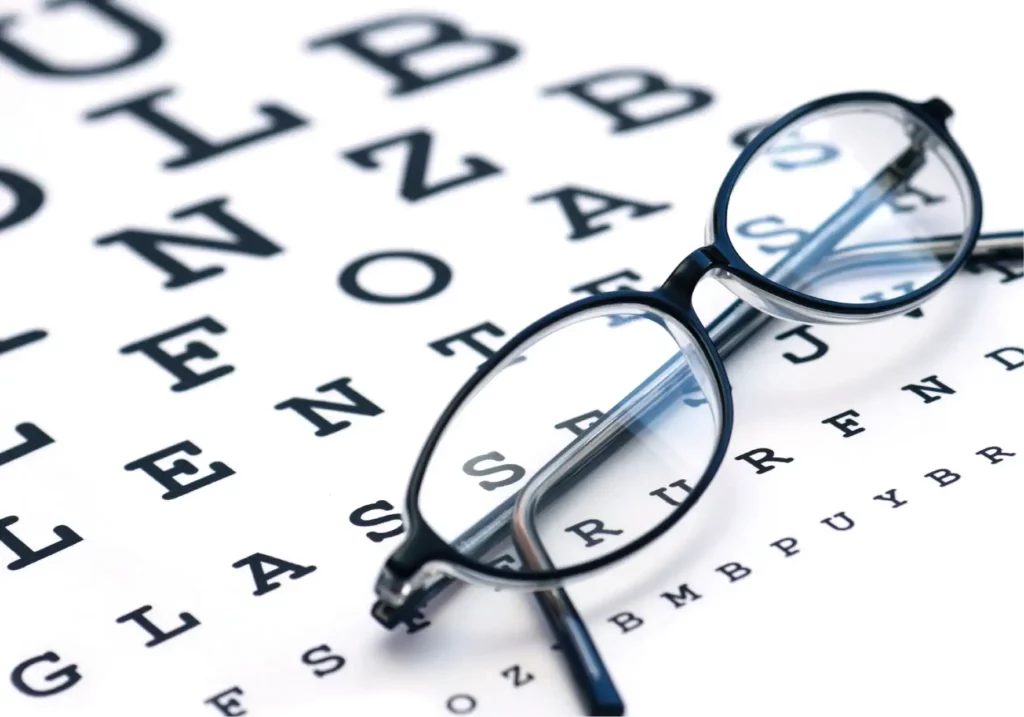
The cost of these lenses varies depending on several factors, such as the specific features you choose (like transition lenses or UV protection), the quality of the lens material, and any customizations you might need.
Generally, the average cost of trifocal lenses ranges from $120 to $200. However, this price can increase significantly with additional features or customizations, potentially reaching up to $1,000 in some cases.
In comparison to other types of lenses, trifocal lenses are typically more affordable than progressive lenses, which can cost from $85 to $400 for basic versions, and up to $1,000 for premium designs.
Discover remarkable transformations with our comprehensive guide on Botox before and after eyes.
Trifocal Lenses Vs Multifocal Contact Lenses
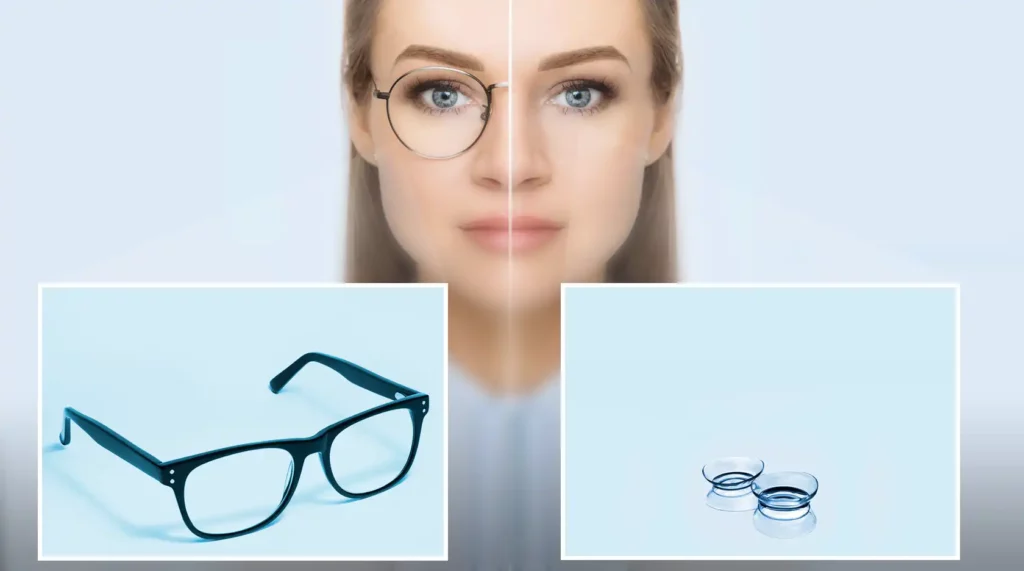
Following are the key differences between the use of Trifocal Lenses and Multifocal Contact Lenses:
Vision Correction Approach
Trifocal Glasses have three separate areas, each for seeing things far away, at a middle distance, and up close. Whereas Multifocal Contact Lenses use a smooth blend or circular patterns to help you see at different distances, without separate zones.
Cost Over Time
Multifocal Contact lenses might have a higher ongoing cost than Trifocal Lenses due to replacements and care products.
Maintenance and Care
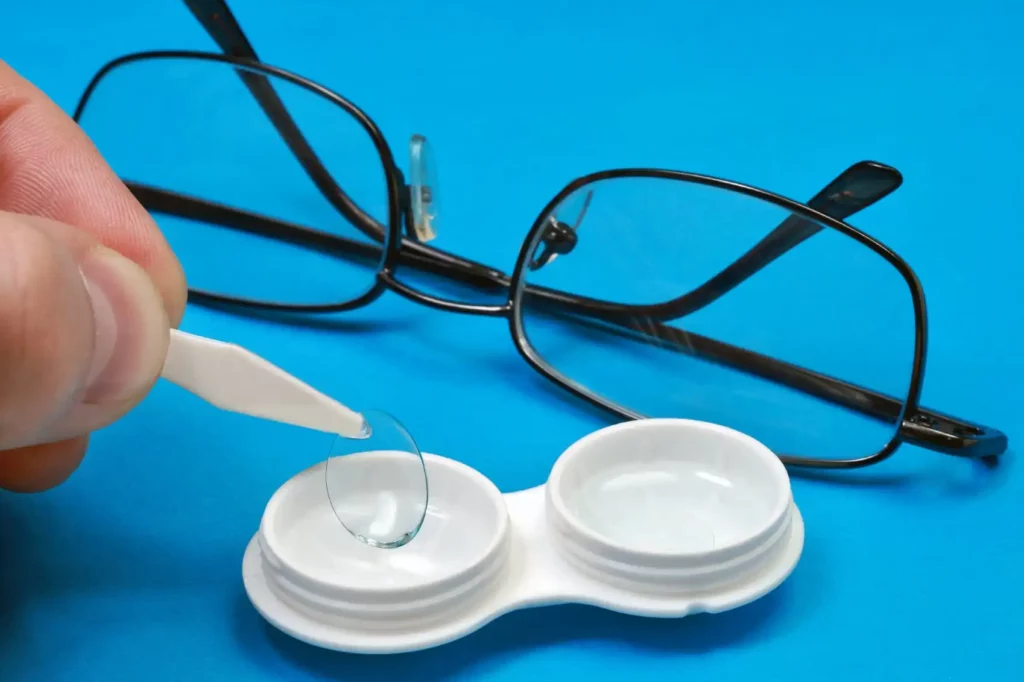
Trifocal Lenses are used with glasses which generally require less daily maintenance as compared to Multifocal contact lenses which require regular cleaning and care.
Aesthetics and Lifestyle Considerations
Multifocal Contact lenses offer a glasses-free look, which might be preferable for sports or fashion reasons.
Conclusion
In conclusion, Trifocal lenses are a fantastic option for comprehensive vision correction. The design of these lenses offers the convenience of not needing to change glasses for different tasks and ensures clear vision across a range of distances. Therefore, if you are suffering either from nearsightedness or farsightedness, its better to wear your trifocal lens as often as possible.
How long does eye strain last? Find out the duration of eye strain and find relief with our informative guide.
FAQs
Are Progressive lenses the same as Trifocal lenses?
No, progressive lenses and trifocal lenses are not the same. Progressive lenses offer a gradual transition between multiple focal points without visible lines, while these lenses have three distinct areas for near, intermediate, and distance vision with visible lines between them.
How Trifocal Lenses Are Made?
These lenses are made by incorporating three different focal points into a single lens. These lenses are made from various materials such as plastic, polycarbonate and high-index plastics.
What is the difference between Bifocal and Trifocal lenses?
Bifocal lenses have two sections for near and far vision, while these lenses add a third section for intermediate distances, like computer screens.
What is the cost of Trifocal lenses for cataracts?
The cost of Trifocal lenses for cataracts is about $2,945 on average.
Which type of lens is best for Eyesight?
The best type of lens for eyesight depends on your specific vision needs. Single vision lenses are good for one focal point, bifocals for two, and trifocals or progressive lenses for multiple distances.
What is the surgery cost of Trifocal lenses?
The average cost of cataract surgery typically ranges between $3,500 and $7,000 per eye.


